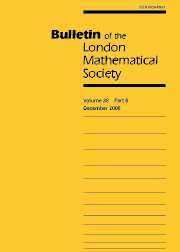Article contents
ORBIT-HOMOGENEITY IN PERMUTATION GROUPS
Published online by Cambridge University Press: 24 July 2006
Abstract
This paper introduces the concept of orbit-homogeneity of permutation groups: a group $G$ is orbit-$t$-homogeneous if two sets of cardinality $t$ lie in the same orbit of $G$ whenever their intersections with each $G$-orbit have the same cardinality. For transitive groups, this coincides with the usual notion of $t$-homogeneity. This concept is also compatible with the idea of partition transitivity introduced by Martin and Sagan.
Further, this paper shows that any group generated by orbit-$t$-homogeneous subgroups is orbit-$t$-homogeneous, and that the condition becomes stronger as $t$ increases up to $\lfloor n/2\rfloor$, where $n$ is the degree. So any group $G$ has a unique maximal orbit-$t$-homogeneous subgroup $\Omega_t(G)$, and $\Omega_t(G)\le\Omega_{t-1}(G)$. Some structural results for orbit-$t$-homogeneous groups, and a number of examples, are also given.
Keywords
Information
- Type
- Papers
- Information
- Copyright
- The London Mathematical Society 2006
- 1
- Cited by

